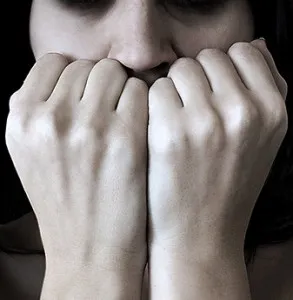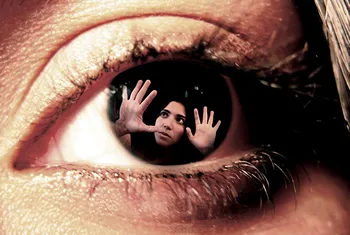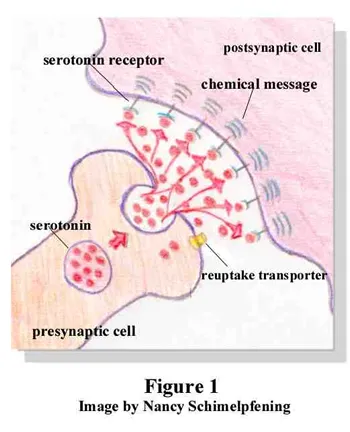|
At times, all of us have felt anxious and moody.
Anxiety, in fact, is one of the universal behavorial
indicators that are shared across regional and
cultural boundaries. Anxiety and depression, in
fact, are a completely normal part of human life.
Who hasn’t studied for an exam without having
test anxiety, only to scoremuch more than what
we’d anticipated? As an evoultionary mechanism,
anxiety was fundamentally important to our survival
as a species – it kept us alert and prepared
for any forseeable difficulty.
Trouble, however, starts when anxiety and depression
seem to strike out of nowhere, last for weeks
to month, and make everyday life difficult, if
not impossible, then we are talking about a serious
medical condition, not mere modd swings. Believe
it or not, anxiety and depression are two of
the most common problems in the world
that strikes pretty much everybody at some point
or time or the other in their lives. Collectively,
a combination of anxiety, depression and sudden
panic attacks are classified under “anxiety
disorders”.

People suffering from anxiety may display
one or several of the following physical symptoms:
trembling, sweating, muscle aches, nausea, fatigue,
palpitation, dry mouth, and cold and clammy hands.
On a deeper level, such people are usually emotionally
apprehensive and irritable and suffer from a
misconstrued feeling of impending doom.

At
the other end of the spectrum is depression,
which is a condition that can
persist for years and have some truly fatal consequences.
It can affect your eating, sleeping habits, impact
one’s self image and self-worth. It must
be kept in mind that a depression is not the
same as a blue mood, neither is it a result of
personal “weakness” – a long
standing, albeit misguided belief in society.
Moreover, depression is not something that can
be easily wished away if one lacks the physical
and emotional environment to pull oneself out
of it. Depression can last
for weeks to years; treatment usually involves
medications and if required, psychotherapy.
Both anxiety and depression remain the two most
widespread problems in the world.
But at the same time, they are also the most
easily treatable – Read More
Anxiety
We all know the external signs
of anxiety: sweaty palms, tight chest,
pounding heart,
erection problems,
Butterflies in the stomach, restlessness, irritability,, trembling
hands, dread, feelings of being out of control
Or impending panic…
Some of the brain events and patterns characteristic of anxiety
include: decreased alpha and theta brain waves (suggestive of decreased
relaxation and calmness); increased high beta activity (suggestive
of Heightened arousal) ; rapid shifts in brain waves and absence
of brain-wave synchrony (suggestive of Uncoordinated and agitated
thought processes) ; elevated levels of stressful and excitatory
biochemicals Including high amounts of epinephrine (adrenaline)
ACTH and cortisol.
Both outwardly and inwardly, then, anxiety
shares many of the features of the fight-or-
flight response. This evolutionary hard-wired
program responds automatically to a perceived
threat by activating our sympathetic
nervous system. In an adrenaline rush
we pour out neurochemicals that accelerate
our metabolism in various ways, all of
them intended to help us deal with some
external threat by running like hell
or ripping its liver out with our teeth.

When the external threat exists, our
response is called fear. In its most
irrational and exaggerated form, this
fear can become phobia. We can respond
to an external appropriately and then
after Activating and using our fight-or-flight
response, we can relax and allow our
body to activate the relaxation response.
During the relaxation response the effects of the fight-flight
response are terminated and erased
And the stress-related biochemicals and their byproducts are normally
cleaned out of the system
BUT in anxiety, the threat is internally
created: We are distressed by some potential
or future event
And since there's no way to fight or flight or flee a potential
or future advent, we are left in a state of arousal. We are still
feeling the threat, but there is no way to escape..

One way to escape anxiety is simply
to turn off the physiological symptoms
of the fight or flight response, like
turning off a faulty warning signal on
a machine. This seems to be one of the
ways in which brain technology works
so effectively to alleviate anxiety:
clearly mind tools have powerful and
in many cases unsurpassed effects in
rapidly producing deep relaxation by
switching on the relaxation response.

Try to imagine being profoundly relaxed
and experiencing anxiety. It's probably
hard for you to do. There's evidence
that deep relaxation and fear are mutually
exclusive, when you are experiencing
one, you cannot truly experience the
other. So, to the degree that you permit
brain technology to relax you, it will
eliminate anxiety.

The image of flipping a switch
switching off your fight or flight
response and switching on your relaxation
response, may seem like an oversimplification.
But there is evidence that there may
be a sort of "master switch" in
the brain that turns on either the
sympathetic or the parasympathetic
system. According to cranial electrostimulation
(CES) researcher Daniel
Kirsch, CES produces "a direct
stimulation of the autonomic nervous
system" that can act "sort
of like switching on the relaxation
response. And CES researcher Ray Smith,
describing a study of people who suffered
from phobias, told me with astonishment
that "what we found, essentially,
was that the CES blocked the subjects'
ability to fear altogether! This
suggests that the old brain… including
the hypothalamus and amygdala, governing
memories and emotional expression,
is the area affected by the electrostimulation." What
Smith found, in other words, was that
stimulation with CES essentially switched
off fear, or the fight or flight response.

Break
the Anxiety Cycle
Try a BT11

Anxiety reduction
is usually felt during the first treatment
although the effects are cumulative
over time. Depression and insomnia
are usually controlled, if not cured,
in two to three weeks. Users also report
feeling more energetic, focused, and,
well. Although not its primary mechanism
of action, microcurrent treatment Increases
natural endorphin output
DEPRESSION
There
is always hope. Anxiety and Depression
blinds us to that fact.
If we can somehow hold on to our hope, just
maybe we can find a way to get through.

Without emotion,
man would be nothing but a biological
computer. Love, joy, sorrow, fear,
apprehension, anger,
satisfaction, and discontent provide
the meaning of human existence.
Arnold M. Ludwig---1980 |
First I want to warn
you: this is a somewhat long letter.
If I could tell you all I need to in just a few words, believe
me, I would.
| Lately Melissa hasn't felt like
herself. Her friends have noticed
it, too. Lita was surprised when
Melissa turned down her invitation
to go to the mall last Saturday (Melissa
could always be counted on for Retail
Therapy!). There was really no reason
not to go, but Melissa just didn't
feel like it. Instead, she spent
most of the weekend sleeping.
Staying in more than usual isn't
the only change in Melissa. She's
always been a really good student.
But over the past couple of months
her grades have fallen and she
has trouble concentrating. She
forgot to turn in a paper that
was due and is having a hard
time getting motivated to study
for her finals.
Melissa feels tired all the
time but has difficulty falling
asleep. She's gained
weight too. When her
mother asks her what's wrong,
Melissa just feels like crying.
But she doesn't know why. Nothing
particularly bad has happened.
Yet she feels sad all the time
and can't shake it.
Melissa may not realize
it yet, but she is depressed.
|
What
causes depression?
Sometimes friends or family
members recognize that someone
is depressed. They may respond
with love, kindness, or support,
hoping that the sadness will
soon pass.
But not everyone recognizes
depression when it happens
to someone they know.
Some people don't really
understand about depression.
For example, they may react
to a depressed person's low
energy with criticism, yelling
at the person for acting lazy
or not trying harder. Some
people mistakenly believe that
depression is just an attitude
or a mood that a person can
shake off. It's not that easy.
Sometimes even people who
are depressed don't take their
condition seriously enough.
Some people feel that they
are weak in some way because
they are depressed.
|

Being clinically depressed is
very different from the down
type of feeling that all people
experience from time to time.
Occasional feelings of sadness
are a normal part of life, and
it is that such feelings are
often colloquially referred to
as "depression." In
clinical depression, such feelings
are out of proportion to any
external causes. There are things
in everyone's life that are possible
causes of sadness, but people
who are not depressed manage
to cope with these things without
becoming incapacitated.

As one might expect, depression
can present itself as feeling
sad or "having the blues".
However, sadness may not always
be the dominant feeling of a
depressed person. Depression
can also be experienced as a
numb or empty feeling, or perhaps
no awareness of feeling at all.
A depressed person may experience
a noticeable loss in their ability
to feel pleasure about anything.
Depression, as viewed by psychiatrists,
is an illness in which a person
experiences a marked change in
their mood and in the way they
view themselves and the world.
Depression as a significant depressive
disorder ranges from short in
duration and mild to long term
and very severe, even life threatening.

Depression involves the brain's
delicate chemistry — specifically,
it involves chemicals called
neurotransmitters. These chemicals
help send messages between nerve
cells in the brain. Certain neurotransmitters
regulate mood, and if they run
low, people can become depressed,
anxious, and stressed. Stress
also can affect the balance of
neurotransmitters and lead to
depression.
The most
common drugs used today to
treat depression focus their
attention on the brain chemicals,
serotonin and norepinephrine.
Adverse
side effects of antidepressant
drugs
Increasing
evidence, however, now indicates
that another player in the
brain, corticotropin-releasing
factor, should share the spolight.
Studies have shown that abnormally
high activity of this stress
hormone is present in many
cases of depression. Furthermore,
research shows that drugs that
block the action of corticotropin-releasing
factor have the potential to
lift the dismally low spirits
of the depressed. The new insights
help explain how depression
arises and may lead to new
options for prevention and
treatment.BT9
It is important
for people to know that:
Depression
is an illness that can affect
anyone at any age.
It is not connected with and does not develop into insanity |
SYMPTOMS
OF DEPRESSION
 |
An
estimated one in ten Americans
suffer from depression,
an illness that affects
both physical and mental
well-being. Often chronic
in nature, depression can
be triggered by adverse
life circumstances or occur
simply "out of the
blue." Frequently,
a combination of genetic,
psychological and environmental
factors contribute to the
onset of depression.
Depression is much misunderstood by the public, yet
it affects many people of all ages. It is estimated
that one in five people will suffer from depression
at some point in their lives.
Depression
Scale |
Depression is an illness where
the feelings of hopelessness and
helplessness, linkled to the inability
to concentrate, may make it hard
for some people to carry out normal
daily activities.
Depression is an illness with a wide range of physical and
psychological symptoms, which sometimes make it hard to recognise
and understand.
Personality may play a part in depression. Although anyone
can become depressed under particular circumstances, some
people seem to be more vulnerable than others. This may be
because of things that have happened in childhood, such as
abuse, or because of our individual make up (including body
chemistry).
A lot of effective, intelligent and creative people suffer
from depression and yet make an outstanding contribution
to life. Often, information about their depression is only
revealed after their death, as people misunderstand the illness.
Amongst such people are
 Florence
Nightingale and Florence
Nightingale and
 Sir
Winston Churchill, who used
to call depression his "black
dog". Depression can effect
anyone and does not reduce
your value as a human being. Sir
Winston Churchill, who used
to call depression his "black
dog". Depression can effect
anyone and does not reduce
your value as a human being.
The
most common symptoms are set
out below . If these have been
experienced for more than two
weeks it is essential to seek
help. People may suffer from
two or three of these symptoms
but are unlikely to experience
them all.
 Feelings
of helplessness and hopelessness. Feelings
of helplessness and hopelessness.
 Feeling
useless, inadequate, bad. Feeling
useless, inadequate, bad.
 Self
hatred, constant questioning
of thoughts and actions, an
overwhelming need for reassurance. Self
hatred, constant questioning
of thoughts and actions, an
overwhelming need for reassurance.
 Being
vulnerable and "over-sensitive". Being
vulnerable and "over-sensitive".
 Feeling
guilty. Feeling
guilty.
 A
loss of energy and motivation,
that makes even the simplest
tasks or decisions seem difficult. A
loss of energy and motivation,
that makes even the simplest
tasks or decisions seem difficult.
 Self
harm. Self
harm.
 Loss
or gain in weight. Loss
or gain in weight.
 Difficulty
with getting off to sleep,
or (less frequently) an excessive
desire to sleep. Difficulty
with getting off to sleep,
or (less frequently) an excessive
desire to sleep.
 Agitation
and restlessness. Agitation
and restlessness.
 Loss
of sex drive. Loss
of sex drive.
 Finding
it impossible to concentrate
for any length of time, forgetfulness. Finding
it impossible to concentrate
for any length of time, forgetfulness.
 A
sense of unreality. A
sense of unreality.
 Physical
aches and pains, sometimes
with the fear that you are
seriously ill. Physical
aches and pains, sometimes
with the fear that you are
seriously ill.
In severe depression,
these feelings may also include:
 Suicidal
ideas. Suicidal
ideas.
 Failure
to eat or drink. Failure
to eat or drink.
 Delusions
and/or hallucinations. Delusions
and/or hallucinations.
How
may I measure my depression?
|
Get
Your Life Back On Track

| Imagine plugging your brain
into a specially mastered
Black box containing a powerful
(but absolutely safe) technology
that launches you into an
incredible experience of
deep inner peace - an experience
of deep meditation so powerful...it
immediately begins to create
profound, positive changes
in the structure of your
nervous system... |
The
BT9 IS AMAZING FOR DEPRESSION
INTRODUCING
THE BT11 the latest in
the Black box BT9 range
Everyone has a threshold
for what they can handle coming
at them from the world. When that
threshold is exceeded, we attempt
to deal with being pushed over
it with a variety of coping mechanisms,
including anxiety, anger, depression,
overwhelm, sadness, substance abuse,
and many others.
When a person has
trauma during childhood, this threshold
ends up being lower than if the
trauma had not happened, and the
person is more often bothered by
things in their environment that
might not bother other "normal" people.
This means they exhibit, and suffer
from, the above feelings and behaviours
more often. But even the person
with the normal threshold can be
pushed past their threshold from
time to time, depending on what’s
going on for them.
The solution to all of this? Raise
this threshold higher, and this
is precisely what the BT 9 does.
As this happens, your dysfunctional
feelings and behaviours happen
less and less often because it
becomes less and less likely that
whatever is happening in your environment
will push you over it and trigger
these feelings and behaviours in
the first place. As a result, they
fall away — for good.
DRUGS,
DEPRESSION, SMOKING and CES-Cranial
Electrotherapy Stimulation
This is a lot like an athlete
who begins with a certain physical
threshold, but raises it by training
every day until what would have
overwhelmed the person in the beginning
becomes easy.
"I noticed effects
from the first day od using
my BT9. I experienced a greater
sense of well being, I experienced
a sense of euphoria and also
a sense that finally I HAD
found something that is making
changes to me and is living
up to the facts.."
John Gardiner Utah |

Cranial
Electrotherapy, a Profound
Alternative Therapy
C.E.S.- SAFE EFFECTIVE ALTERNATIVE
TO DRUGS IN THE TREATMENT OF DEPRESSION
.
Cranial Electrotherapy Stimulation
(CES) is an FDA approved treatment
for depression .. Over 100 human
and eighteen animal studies have
demonstrated the effectiveness
of CES in treating these and other
disorders. CES involves the introduction
of a very weak electrical current
into the brain. Before you say, "No
way! Not my brain!" understand
CES is not "Shock therapy".
The electrical current used in
CES/BT9 is
typically less than one milliampere.
To put this in perspective, the
current needed to power a light
bulb is about 11,000 times stronger.
No serious side effects have been
reported with CES.
CES
FAQ
CES is not only a drug-free treatment
of these conditions but is more
effective than drugs currently
on the market, with none of their
frequently debilitating side effects.
Homeostasis can be defined as
the tendency for intrinsic balance
within a system. Application of
a therapeutic range of microcurrent
intracranially seems to enhance
the homeostasis of the biological
central nervous system. A change
in one system within the individual
will have correlative effects upon
other systems. Improvements in
mood, cognitive function, self
image, shift of locus of control
to oneself, and sense of well being
can be measured. When CES/BT9 works,
it enhances one's ability to handle
or deal with situations that were
previously beyond the range of
one's control.
Depression
Scale
| Electromedicine (including BT9/CES)
is designed to primarily
impact the electrical nature
of the body. The current
used in CES is very similar
to the electrical fields
naturally present in the
body |

The efficacy of CES has been demonstrated
in many different ways. Studies
have used twenty-seven different
psychometric (pencil and paper)
tests including the Minnesota Multiphasic
Personality Inventory and the State/Trait
Anxiety Inventory. CES has consistently
demonstrated reductions in anxiety
on these tests. Other studies have
measured the physiological manifestations
of anxiety before and after CES
treatment. Slowing of brain waves
and respiration rate, as well as
reduction in blood pressure are
physical signs of stress reduction
that have been documented with
CES treatment. One placebo-controlled
study evaluated the effects of
CES treatment in twenty individuals
with chronic stress symptoms of
at least a year's duration. All
of them had failed to respond to
medication. Muscle tension, heart
rate and finger temperature were
measured before, immediately after,
and one week following a single twenty minute CES treatment. Muscle tension and heart rate decreased
and finger temperature increased
immediately after treatment in
those receiving active CES treatment
but not in the placebo (sham CES)
group. One week after treatment,
those who had received active CES
treatment still had significantly
reduced muscle tension and heart
rate! This is one of the many advantages
of CES over medications. Whereas
medications only work as long as
they are taken, CES effects are
long lasting and cumulative.
You don't have to be "sick" or "stressed-out" to
use the BT9/CES and realize its
benefits. CES is a life-enhancing
instrument of potential value
to everyone. Its uses are wide
ranging. Some people use it as
an adjunct to meditation practice
each morning. Others during peak
stressor moments that hit unexpectedly
in the course of a day. Who hasn't
experienced those times when
we are about to "lose it?" Putting
the unit on in these situations
even just briefly--perhaps for
as little as ten minutes-- can
help curb that anxiety and serve
as a reminder that one needs
to be with ones self in a different
way.
CES also represents a
significant affirmation that
you have the power within to
change your mental state and
that you are willing to take
active steps to create the time
and the space to do so.
Using
waveforms at a level of current
similar to the body's own, MET
bridge cellular communications
help re-establish the normal
electrical flow.
CES
FAQ
(frequently asked questions)
Anxiety
and depression are the most
widely experienced negative
states
One curious quality
of anxiety is that, since the external
threat is not present, our attention
and fear become focused on the
symptoms of the anxiety itself.
Thus we begin to fear that because
our breathing is constricted, we
will stop breathing; that because
our heart is thumping, we will
have a heart attack; and so on.
A quick way to stop anxiety is
to turn our attention away from
it. You may have had the experience
of suffering anxiety and then being
distracted by something more urgent.
By the time you remember how anxious
you were, your anxiety has gone.
Anxiety is a response to a perceived
threat; it makes sense that if
we forget about or have our attention
diverted from the threat, then
the physiological symptoms will
disappear quickly.
DRUGS,
DEPRESSION, SMOKING and CES-Cranial
Electrotherapy Stimulation
Affectiveness of the NET or Brain
Tuner device was established by
a Chinese Acupuncturist, Dr. Wen,
in Hong Kong in the 1970s by testing
hundreds of patients at a clinic,
most of whom were on drugs of one
kind or another, alcohol, nicotine,
heroin, etc, consciously or unconsciously
trying to relieve stress, largely
a mental condition?
It seems that the body -- or Brain
-- gives up making its own pain-killers,
Endorphins, when a person turns
to drugs;
but putting a weak EM signal into
the; body, especially the head
area, stimulates the brain into
producing Endorphins again. Amazingly,
the craving for the drug disappears
in three to ten days and without
withdrawal symptoms!
The Brain Tuner (BT-9) uses a
complex waveform that, according
to Beck, produces many frequency
harmonics simultaneously—"all
known beneficial frequencies for
the natural stimulation of the
brain’s neurotransmitters." …
THE
BT11
the latest in the Black box BT9 range
An inexpensive and effective
treatment that could alleviate
or eliminate Anxiety and depression
disorders clearly could have an
enormous
economic
and social impact on our future
|
|
|